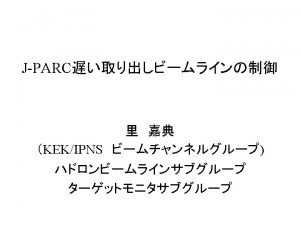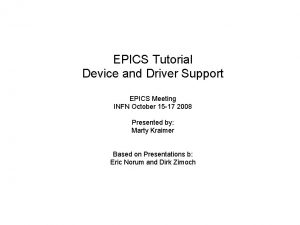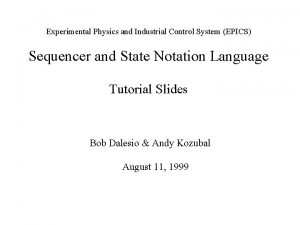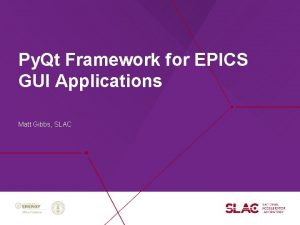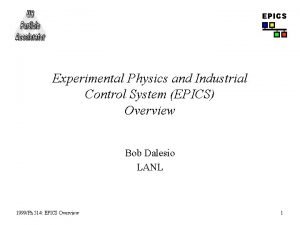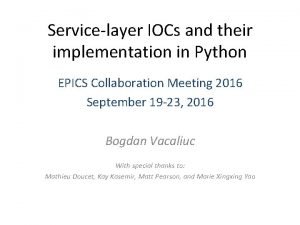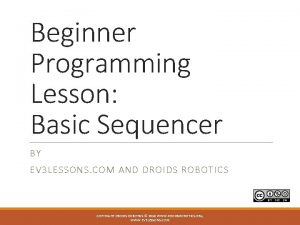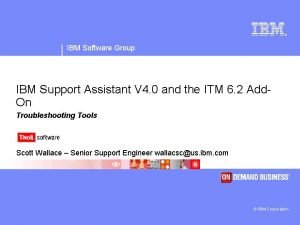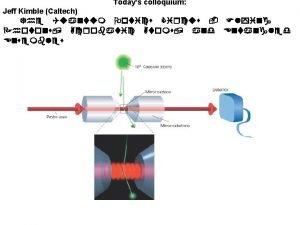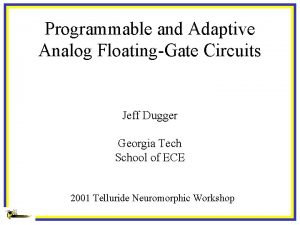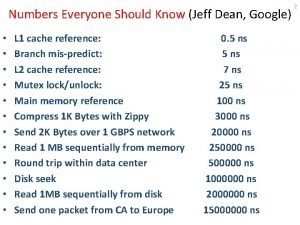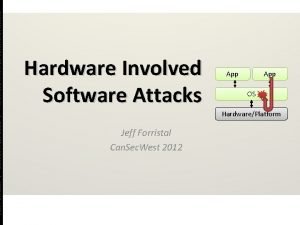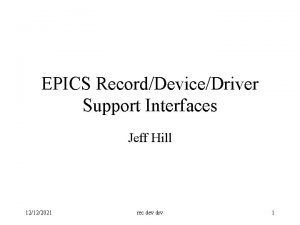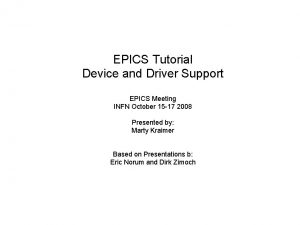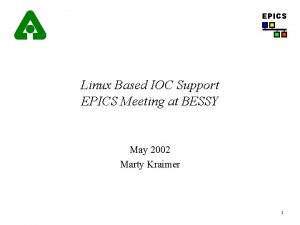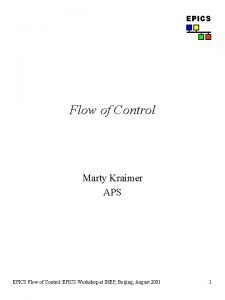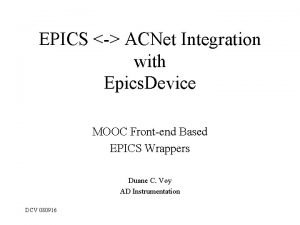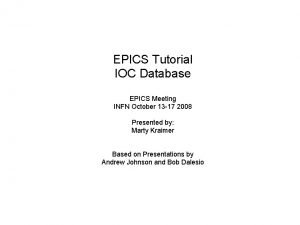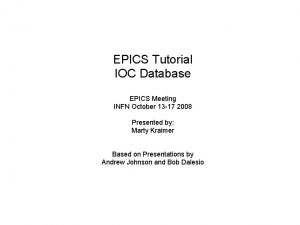EPICS RecordDeviceDriver Support Jeff Hill Outline EPICS Software
















![Get Units typedef long rec. Get. Units_t ( struct db. Addr *paddr, char units[8]); Get Units typedef long rec. Get. Units_t ( struct db. Addr *paddr, char units[8]);](https://slidetodoc.com/presentation_image_h2/051b9aee6ee1476953159a69555ca885/image-17.jpg)





































- Slides: 54

EPICS Record/Device/Driver Support Jeff Hill

Outline • • EPICS Software Architecture Review writing record support writing device support writing driver support creating EPICS status codes using EPICS IO address formats installation

EPICS Software Architecture Client Tool CA Client CA Server DB Common Record Support Device Support Driver Support IO Plant Optional

Record Support • provides implementation for a record type • plugs into “database common” environment • must prepare a record definition file which defines the data structure - xxx. dbd • must supply a C source file which provides the execution semantics • many examples in $(EPICS)/base/src/rec

Record Description File xxx. dbd recordtype(xxx) { include “db. Common. dbd” field(PREC, DBF_DOUBLE) prompt(“Display Precision”) promt. Group(GUI_DISPLAY) }. . . }

Record Support Routines provide execution semantics • • initialize record instance record processing special record processing convert database address initialize record type get array info set array info • get units • get precision • get string for field’s enumerated value • set enumerated field’s value using string • graphic/control/alarm limits

Initialize Record Type typedef long rec. Init_t (); • record type specific initialization

Initialize Record Instance (init rec) typedef long rec. Init. Instance_t (void *precord, int pass); • two pass record instance initialization • initializations private to this record performed when pass==0 • initializations referring to other records performed when pass==1

Record Processing typedef long rec. Process_t (void *precord); • record personality implemented here • see the application developers guide for the details

Before Record Processing • decision to process a record • check for record active (pact TRUE) • check that the record disabled.

Record Processing Routine • • • set record active while it is being processed perform I/O (with aid of device support) check for record specific alarm conditions raise database monitors request processing of forward links

Asynchronous Record Processing • • block scan tasks for slow devices? not! initiate the I/O operation and set pact TRUE return immediately without completing record processing when I/O operation completes call record processing again set pact FALSE inside record processing

Special Record Processing long rec. Special_t (struct db. Addr *paddr, int after); • the file “special. h” defines special field attributes • the record description tags fields with these attributes • if field has special attribute >= 100 then this routine is called before/after modifying the field

Convert Database Address typedef long rec. Cvt. Dbaddr_t (struct db. Addr *paddr); • supply this routine only if the field is not stored within the record data structure • Example: fields that are arrays

Get Array Info typedef long rec. Get. Array. Info_t ( struct db. Addr *paddr, long *no_elements, long *offset); • arrays are variable sized up to a maximum specified by “rec. Cvt. Db. Addr()” • this routine identifies the current length • offset!=0 is only used for ring buffers

Put Array Info typedef long rec. Put. Array. Info_t( struct db. Addr *paddr, long n. New); • called when the array length is modified by db. Common • Ex: client (or another record) writes array
![Get Units typedef long rec Get Unitst struct db Addr paddr char units8 Get Units typedef long rec. Get. Units_t ( struct db. Addr *paddr, char units[8]);](https://slidetodoc.com/presentation_image_h2/051b9aee6ee1476953159a69555ca885/image-17.jpg)
Get Units typedef long rec. Get. Units_t ( struct db. Addr *paddr, char units[8]);

Get Precision typedef long rec. Get. Precision ( struct db. Addr *paddr, long *precision); • suggested number of digits used to display the field’s analog value

Get String Corresponding to Field’s Enumerated Value typedef long rec. Get. Enum. Str_t ( struct db. Addr *paddr, char *pbuffer); • special string conversion • used to associated a string with a binary state

Get String Table for Field With Enumerated Value typedef long rec. Get. Enum. Strs_t ( struct db. Addr *paddr, struct dbr_enum. Strs *p); • used to obtain a table of strings for all states

Set Enumerated Value With String typedef long rec. Put. Enum. Str_t ( struct db. Addr *paddr, const char *pbuffer); • sets the current state using a string

Graphic/Control/Alarm Limits typedef long rec. Get. Graphic. Double_t ( struct db. Addr *paddr, struct dbr_gr. Double *p); typedef long rec. Get. Control. Double_t ( struct db. Addr *paddr, struct dbr_ctrl. Double *p); typedef long rec. Get. Alarm. Double ( struct db. Addr *paddr, struct dbr_ctrl. Double *p); • called to obtain the analog limits

Record Support Entry Table struct rset ai. RSET={ RSETNUMBER, report, initialize, init. Instance, process, special, get. Value, cvt. DBAaddr, get. Array. Info, put. Array. Info, get. Units, get. Precision, get. Enum. Str. Tbl, put. Enum. Str, get. Graphic. Double, get. Control. Double, get. Alarm. Double}; • set entry to NULL if default action OK

Device Support • interface between device driver and record • intimate knowledge of record(s)

Device Support Routines (Analog Input Record) • initialization • report • initialize instance • read ai device value • linear convert • attach to device interrupt

Device Support Header Files #include <ai. Record. h> #include <dev. Sup. h> #include <db. Scan. h>

AI Device Initialization long ai. Dev. Init (unsigned pass) • common to all record types • record instance independent initialization • called, pass = 0, prior to initializing each record during "ioc. Init()" • called, pass = 1, after initializing each record during "ioc. Init()"

AI Device Report long ai. Dev. Report (struct ai. Record * pai, int level); • common to all record types • called once for every record instance when the user types "dbior <level>" • device status to "stdout" from this routine • detail increases with increasing "level"

AI Device Initialization (Record Specific) long ai. Dev. Init. Instance(struct ai. Record *pai) • called from within “ioc. Init()” • once for each rec inst attached to device p. Priv = (struct XXXX *) calloc(1 u, sizeof(struct XXXX); pai->dpvt = (void *) p. Priv; • the device address (pai->inp) is normally verified here

Device Interrupt Causes Record to be Processed • device supports “scan on interrupt” • higher scan rate • scan synchronized with device • device scans IO - change of state results in record processing

Each Interrupt Source • prior to enabling and attaching to interrupt • before returning from ai. Dev. Get. Io. Int. Info() scan. Io. Init(&p. XXXX->io. Scan. Pvt); • number of ”io. Scan. Pvt“ allocated depends on the interrupt granularity of device • one interrupt for all signals • or one for each signal

Each Interrupt Occurrence scan. Io. Request(p. XXXX->io. Scan. Pvt); • safe to call scan. Io. Request() from ISR • don’t call scan. Io. Request() until after database init (“ioc. Init()”) completes

AI Device Get IO Interrupt Info long ai. Dev. Get. Io. Int. Info ( int cmd, struct ai. Record *pai, IOSCANPVT *ppvt); • associates interrupt source with record *ppvt = p. XXX->io. Scan. Pvt; • cmd==0 - insert into IO interrupt scan • cmd==1 - remove from IO Interrupt scan

Read Analog Device Value long ai. Dev. Read_(struct ai. Record * pai) { long rval; if (device OK) then rval=p. Dev. Memory. Map-> ai. Register[pai->dpvt->signal]; pai->rval = rval; else rec. Gbl. Set. Sevr(pai, READ_ALARM, INVALID_ALARM); endif }

AI Device Linear Convert long ai. Dev. Linear. Conv ( struct ai. Record *pai, int after); • Setup the slope (and any offset) for the conversion to engineering units if (!after) then return S_XXXX_OK; endif /* A 12 bit DAC is assumed here */ pai->eslo = (pai->eguf - pai->egul)/0 xfff; pai->roff = ? ? ;

From convert() in ai. Record. c double val; val = pai->rval + pai->roff; /* * adjust with slope/offset * if linear convert is used */ if(pai->aslo!=0. 0) val*=aslo; if(pai->aoff!=0. 0) val+=aoff; val = (val * pai->eslo) + pai->egul;

Asynchronous Devices • read/write routine sets “PACT” true and returns zero for success. • asynchronous IO completion call-back completes record processing • don’t process a record from within an ISR

Example Asynchronous Read long dev. Xxx. Read (struct ai. Record *pai) { if (pai->pact) [ return S_dev. Xxx_OK; /* zero */ } pai->pact = TRUE dev. Xxx. Begin. Async. IO(pai->dpvt); return S_dev. Xxx_OK; }

Example Asynchronous Read Completion void dev. Xxx. Async. IOCompletion(struct ai. Record *pai, long io. Status) { struct rset *prset = (struct rset *) pai->rset; db. Scan. Lock(pai); if (io. Status != S_dev. Xxx_OK) { rec. Gbl. Set. Sevr(pai, READ_ALARM, INVALID_ALARM); } (*prset->process)(pai); db. Scan. Unlock(pai); }

Device Support Entry Table struct ai_dev_sup { long number; /* number of items in table */ ai. Dev. Report_t *report; dev. Init_t *init; ai. Dev. Init. Rec_t *init. Rec; ai. Dev. Get. Io. Int. Info_t *get. Io. Int. Info; ai. Dev. Read_t *read; ai. Dev. Linear. Conv_t *special. Linear. Conv; }; LOCAL dev. Init_t dev. Init. XXXX; LOCAL ai. Dev. Init. Rec_t ai. Dev. Init. Rec. XXXX; LOCAL ai. Dev. Get. Io. Int. Info_t ai. Dev. Get. Io. Int. Info. XXXX; LOCAL ai. Dev. Read_t ai. Dev. Read. XXXX; LOCAL ai. Dev. Linear. Conv_t ai. Dev. Linear. Convert. XXXX; struct ai_dev_sup dev. Ai. XXXX = { 6 L, /* external scope */ ai. Dev. Report. XXXX, ai. Dev. Init. Rec. XXXX, ai. Dev. Get. Io. Int. Info. XXXX, ai. Dev. Read. XXXX, ai. Dev. Linear. Convert. XXXX };

Driver Support (Optional) • interface device initializes prior to drivers that use it • ex: VXI resource manager, MXI, GPIB, bit bus, AB DF 1, CAMAC, CAN, bus repeaters • when you want to limit a device driver's knowledge of EPICS

Driver Support Routines • initialize • report

Driver Initialize long drv. Init. Func(int after); • device driver specific initialization here • this routine is called twice by ioc. Init() • prior to database initialization with "after==FALSE" • after database initialization with "after==TRUE"

Driver Report long • • drv. Report. Func(int level); called when the user types "dbior <level>" provides device status to stdout increasing details with increasing "level" raw addresses, raw signal values, and device status • used by persons maintaining the hardware

Driver Support Entry Table #include <drv. Sup. h> typedef long drv. Init. Func_t (void); typedef long drv. Report. Func_t (int level); LOCAL drv. Report. Func_t drv. XXXXReport; LOCAL drv. Init. Func_t drv. XXXXInit; struct drv. Sup. Entry. Table { long number; drv. Report. Func_t *report; drv. Init. Func_t *init; }drv. XXXX = { 2 L, /* the number of functions */ drv. Report. XXXX, drv. Init. XXXX };

EPICS “Built-In” IO address Formats

IO Type Isn’t “Built-In” /* from $EPICS/base/include */ #include <link. h> • use "INST_IO" addressing • parse parameter string in device support

Record Support Installation • add to db description “tn. Include. dbd” include “xxxrecord. dbd”

Device Support Installation • add to the db description “tn. Include. dbd” device (xxx, INST_IO, dev. Xxx. Yyy, “yyy device”) xxx - record type INST_IO - IO addressing type dev. Xxx. Yyy - device support entry table name “yyy device” - configuration menu label for DTYP field • load object modules prior to "ioc. Init()" • optionally install error codes • •

Driver Support Installation • add to db description “tn. Include. dbd” driver (drv. Xxx) • drv. Xxx - driver support entry table name • load object modules prior to "ioc. Init()" • optionally install your error codes

Record Instance record (ai, ”my. Record. Name") { field(DTYP, ”yyy device") field(SCAN, "I/O Intr") field(INP, "@yyy 3") field(LINR, "LINEAR") field(EGUF, "10. 0000000") field(EGUL, "-10. 0000000") field(HOPR, "10. 0000000") field(LOPR, "0. 0000000 e+00") }

EPICS Status Codes (Optional) • define a subsystem code and error constants in your subsystem's header file #define M_epvxi (520 <<16) /*VXI Driver*/ #define S_XXX_bad (M_xxxx| 1) /* a really bad failure*/ #define S_XXX_worse (M_xxxx| 2) /* even worse */ • zero is always a success code #define S_XXX_OK 0 • -1 is always a failure code

Install ERROR Codes (Optional) • Define error codes in sub-systems header file • Add your sub-system's header file to “ERR_S_FILES in config/CONFIG_SITE” ERR_S_FILES += <path>/drv. XXX. h • Type "gmake" in "$EPICS/base”

More Information • • many examples in $(EPICS)/base/src/rec many examples in $(EPICS)/base/src/dev many examples in $(EPICS)/base/src/drv “Application developers Guide” by Marty Kraimer (on the WEB) • “Record Reference Manual” by Marty Kraimer (on the WEB)
 Quote one topic sentence
Quote one topic sentence Support control and movement lesson outline
Support control and movement lesson outline Minor details examples
Minor details examples Example of it
Example of it Epics channel access
Epics channel access Epics database
Epics database Most famous epics
Most famous epics Facts about epic poetry
Facts about epic poetry Pericles and the bull
Pericles and the bull Epics tutorial
Epics tutorial What is epic
What is epic Epics calc record
Epics calc record Epics sequencer
Epics sequencer Epics channel access
Epics channel access Epics channel access
Epics channel access Css epics
Css epics Definition
Definition Epics channel access
Epics channel access How many epics are there
How many epics are there Epics qt
Epics qt Epics database
Epics database Epics control system
Epics control system Python epics
Python epics Epics calc
Epics calc Epics 7
Epics 7 Structure of an epic poem
Structure of an epic poem Epics sequencer
Epics sequencer Epics ioc
Epics ioc Software engineering 1 course outline
Software engineering 1 course outline Ibm support assistant workbench
Ibm support assistant workbench Satori software
Satori software Walmart vs target swot analysis
Walmart vs target swot analysis Jeff kimble caltech
Jeff kimble caltech Jeff masters weather underground
Jeff masters weather underground Jeff doucet death
Jeff doucet death Jeff dugger
Jeff dugger Jeff walker launch template
Jeff walker launch template Participants of money market
Participants of money market Daddy's hands poem
Daddy's hands poem Jeff wall manet
Jeff wall manet Patterns of power jeff anderson
Patterns of power jeff anderson Jeff dean google scholar
Jeff dean google scholar Jeff sher
Jeff sher Jeff zemsky
Jeff zemsky Jeff wall insomnia
Jeff wall insomnia Mlm organisation
Mlm organisation Jeff wielgopolan
Jeff wielgopolan Jeff rochon
Jeff rochon Jeff forristal
Jeff forristal Jeff heflin
Jeff heflin International financial management jeff madura 13th edition
International financial management jeff madura 13th edition Dr jeff tucker
Dr jeff tucker Jeff quackenbush newark
Jeff quackenbush newark Jeff thrush
Jeff thrush Folk gang sign
Folk gang sign




